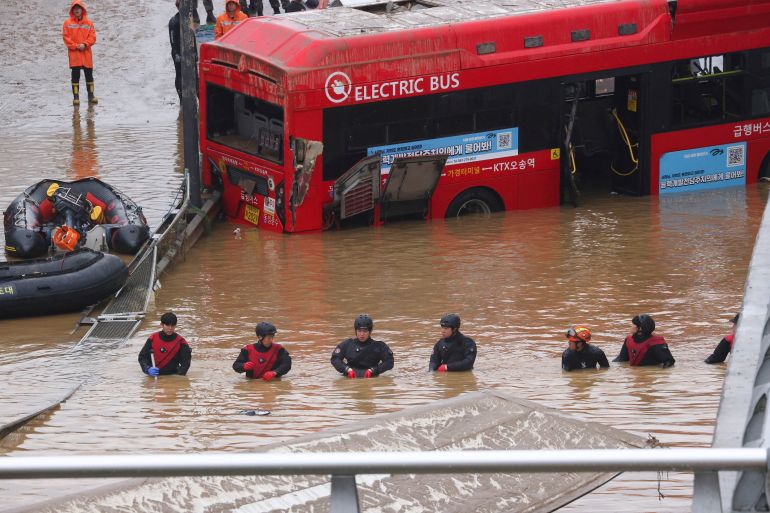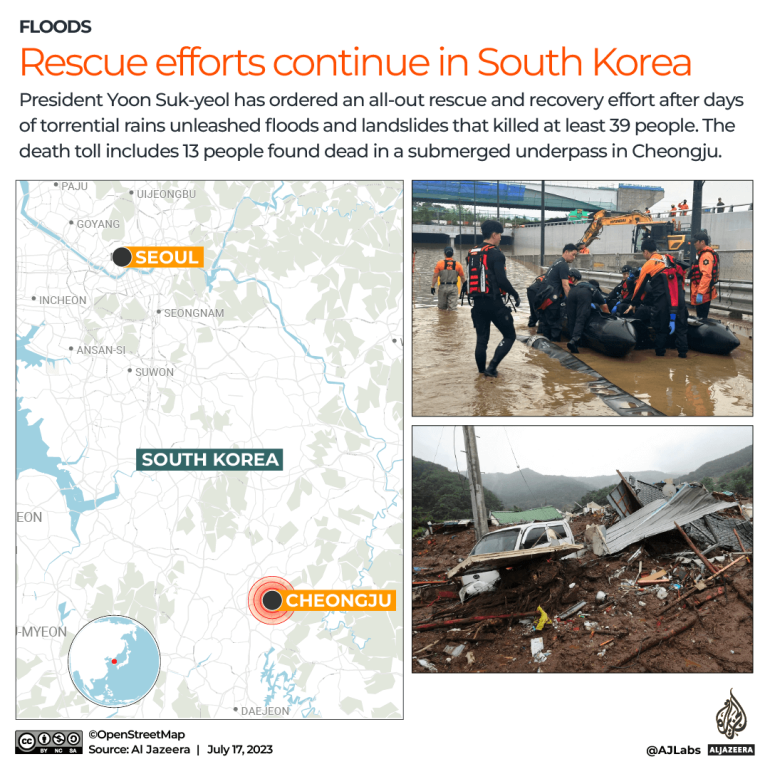Yoon orders all-out effort after heavy rains kill 39 in S Korea
South Korean president pledges to mobilise all resources for rescue efforts as workers pull 13 bodies from tunnel hit by flash flooding.

South Korean President Yoon Suk-yeol has ordered an all-out rescue and recovery effort after days of torrential rains unleashed devastating floods and landslides that killed at least 39 people.
The death toll on Monday included 13 people found dead in a submerged underpass in the central city of Cheongju in North Chungcheong Province.
Keep reading
list of 4 itemsSeven dead in S Korea as flash floods trap 15 vehicles in tunnel
South Korea’s Yoon promises $150m aid after Zelenskyy talks
S Korea landslides, floods kill more than 20, thousands evacuated
Yoon, on his return to Seoul following a trip to Ukraine, convened an intra-agency meeting on the disaster response and called for authorities to make the utmost effort to rescue victims.

“There is no way to suppress my sadness. I pray for the souls of those killed in the heavy rains and offer words of comfort to the bereaved families,” the president said.
“We all need to take the situation gravely and mobilise all available resources.”
Yoon also pledged support for recovery work, including designating affected areas as special disaster zones.
South Korea, which is at the peak of its summer monsoon season, has been battered by heavy rains since July 9. The downpours have caused widespread flooding and landslides, mostly in the country’s central and southern regions.
In Cheongju, rescue workers pulled four more bodies overnight from a tunnel where some 16 vehicles, including a bus, were swamped by a flash flood after a levee of a nearby river collapsed.
Another nine bodies had been pulled out of the tunnel on Saturday.
Seo Jeong-il, chief of the city’s fire department, said nine survivors were rescued from the tunnel and that the exact number of passengers trapped in vehicles was not immediately clear.
Fire officials estimated the tunnel filled with water in as little as two or three minutes. Nearly 900 rescue personnel, including divers, were dispatched to the scene where photos and videos showed workers establishing a perimeter and pumping brown water out of the tunnel.
Al Jazeera’s Jessica Washington, reporting from Cheongju, said the search effort was “still very much under way”.
“In terms of progress, most of the water has been drained from the tunnel. Some of the factors hampering the rescue process has been heavy mud, while the central parts of the tunnel, still has waist-high water,” she said. “Many residents here are beginning to ask hard questions of the local officials, including why this underpass has been open despite the severe weather.”
The Korea Meteorological Administration, meanwhile, issued more heavy rain warnings for the surrounding province as well as southern parts of the country.
It said the central and southern provinces were likely to receive an additional 100mm to 200mm of rain by Tuesday night.
The Yonhap news agency, citing disaster authorities, said the highest death toll was recorded in the southeastern North Gyeongsang Province, where 19 people died, largely due to huge landslides that engulfed houses with people inside.
Nine people remain missing, including eight in North Gyeongsang, while 34 people have been reported injured, it said.
Across the country, the rains forced the evacuation of some 10,570 people from their homes and left 28,607 households without electricity, it added.
Yoon, speaking at the disaster response meeting, said, “This kind of extreme weather event will become commonplace.” South Koreans “must accept climate change is happening and deal with it,” he said.
The idea that extreme weather linked to climate change “is an anomaly and can’t be helped needs to be completely overhauled”, he added, calling for “extraordinary determination” to improve the country’s preparedness and response.
South Korea is regularly hit by flooding during the summer monsoon period but the country is typically well-prepared and the death toll is usually relatively low.
It endured record-breaking rains and flooding last year, which killed at least 11 people. They included three people trapped in a Seoul semi-basement apartment of the kind that became internationally known because of the Oscar-winning Korean film Parasite.
The South Korean government said at the time the 2022 flooding was the heaviest rainfall since Seoul’s weather records began 115 years ago.